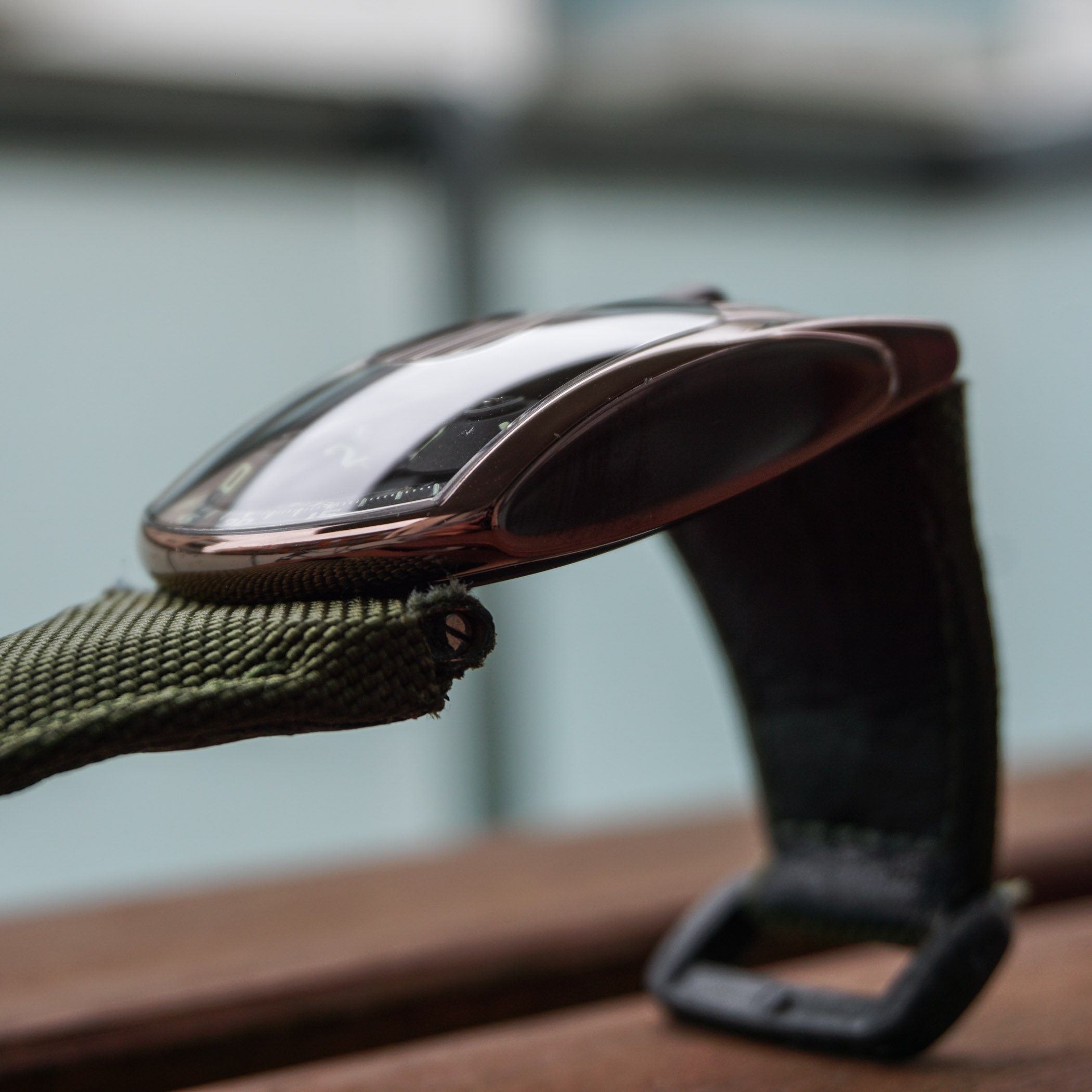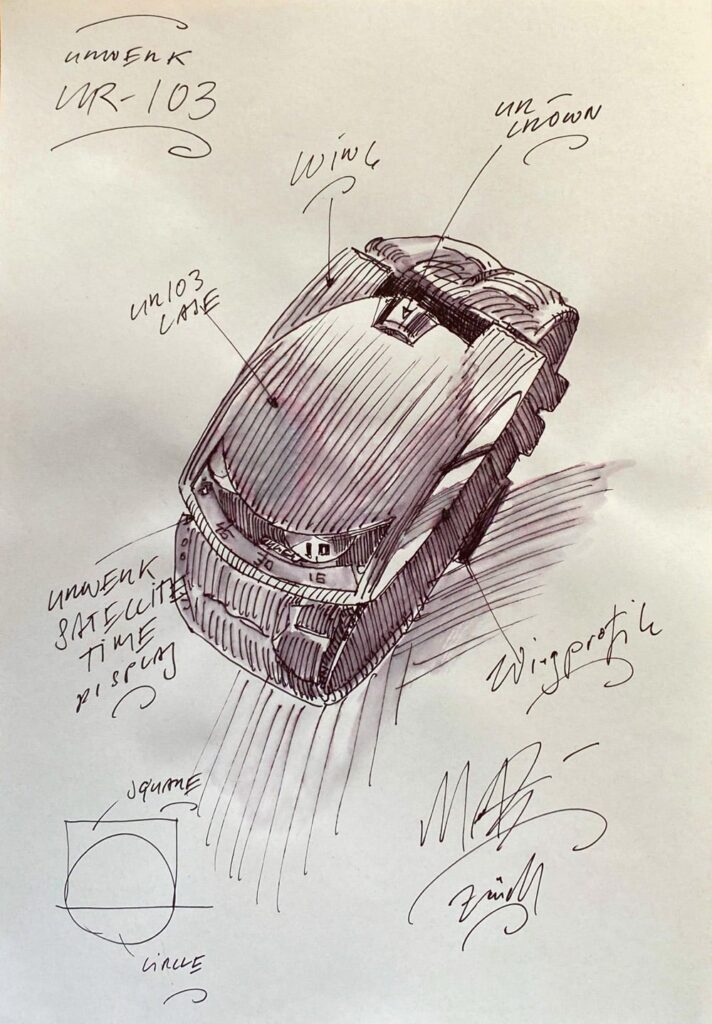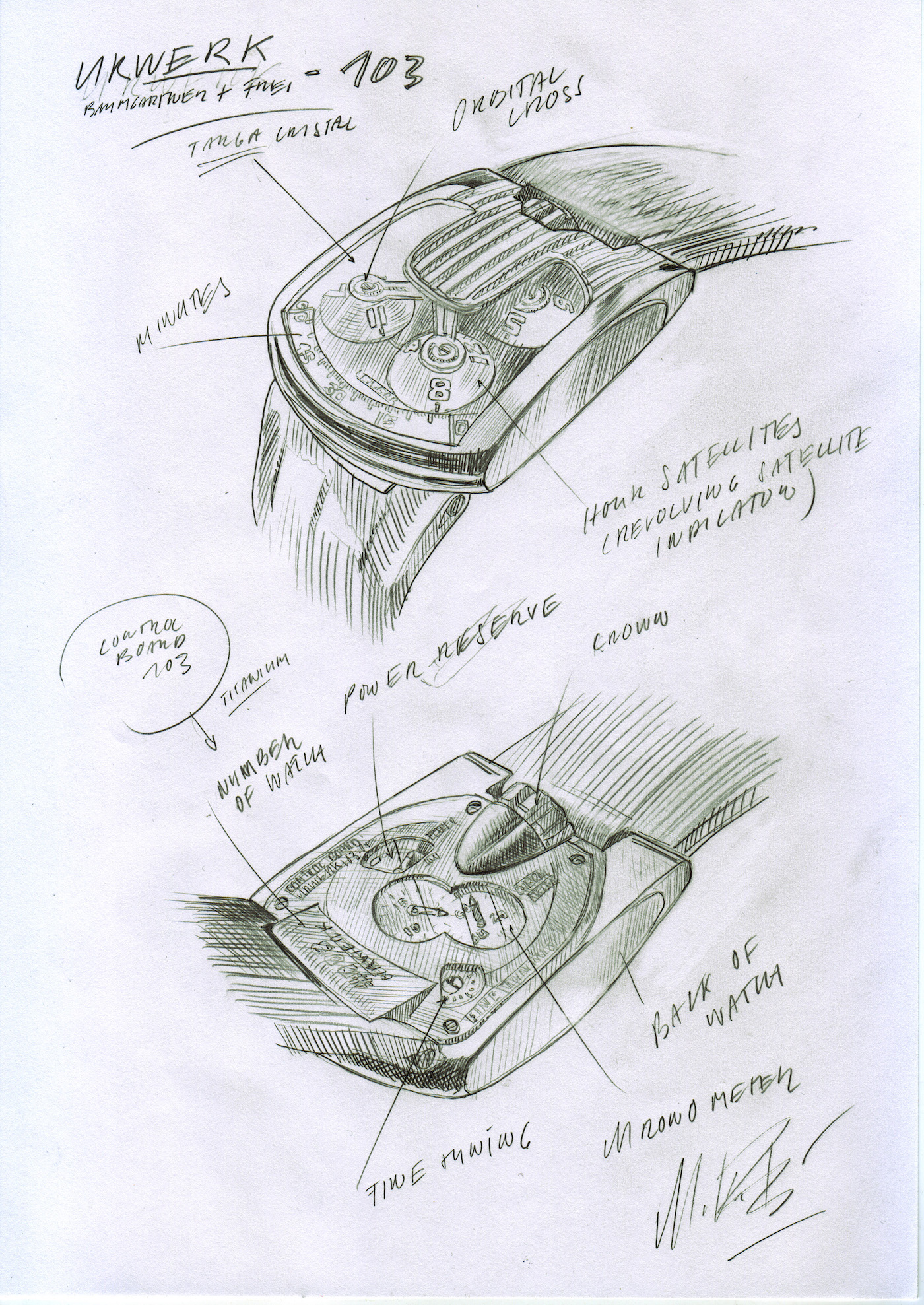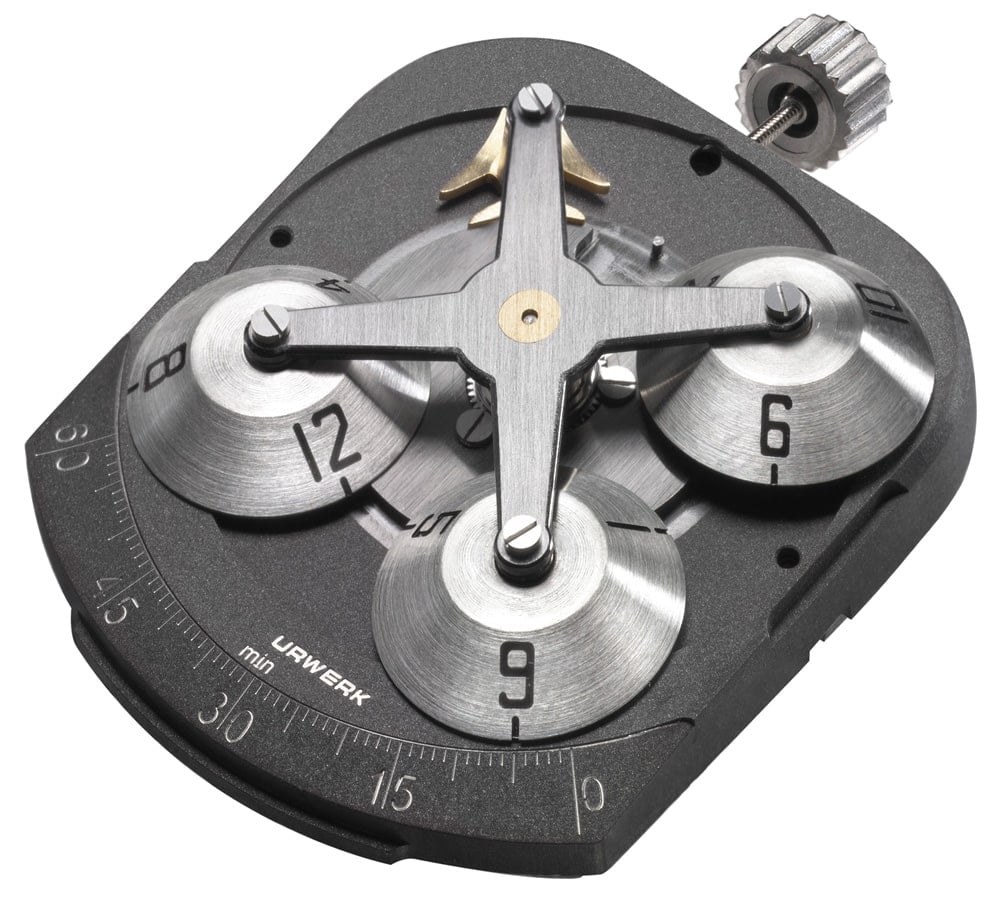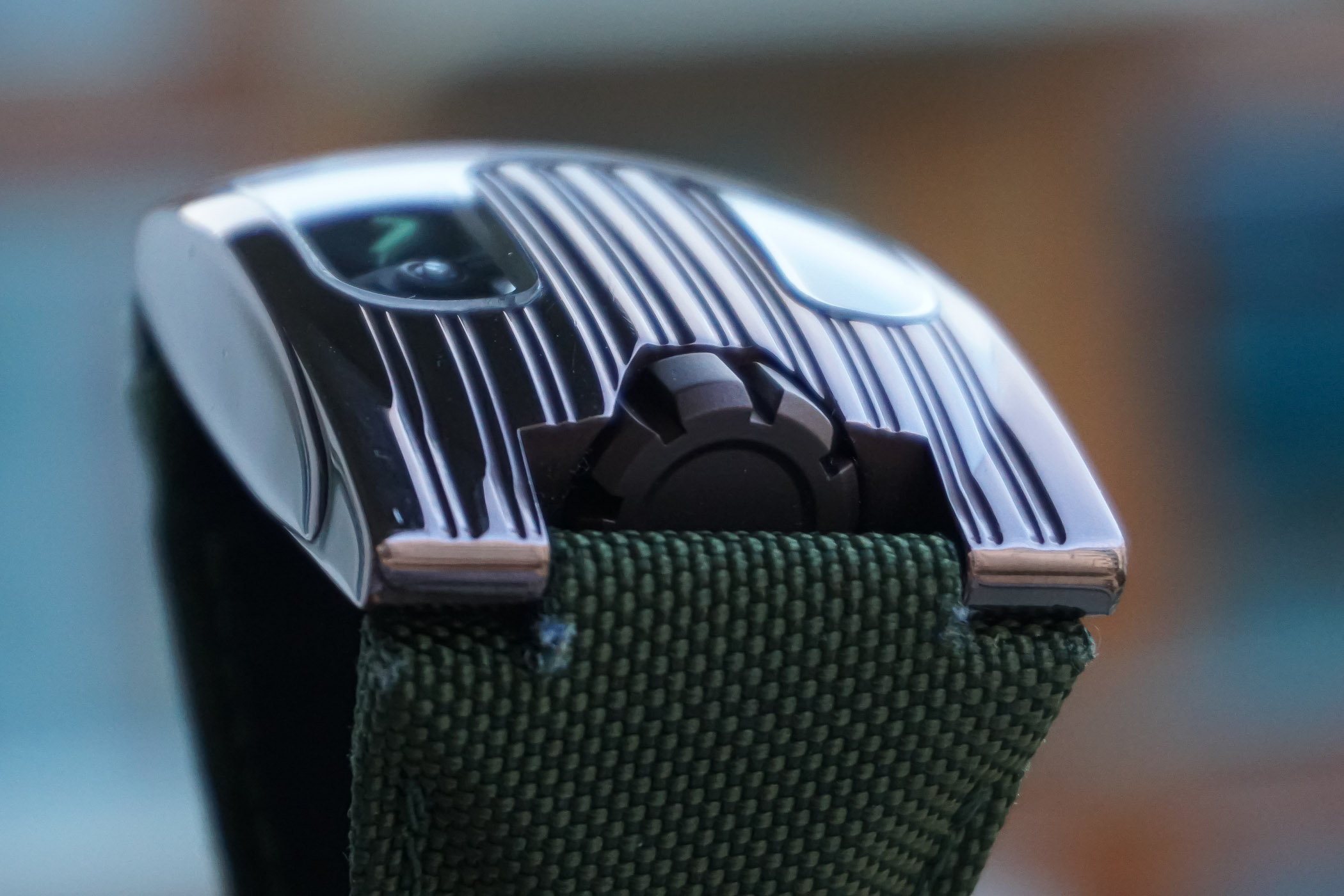Up Close and Personal with the URWERK UR-103
A spaceship for the wrist and Q&A with Martin Frei of URWERK.
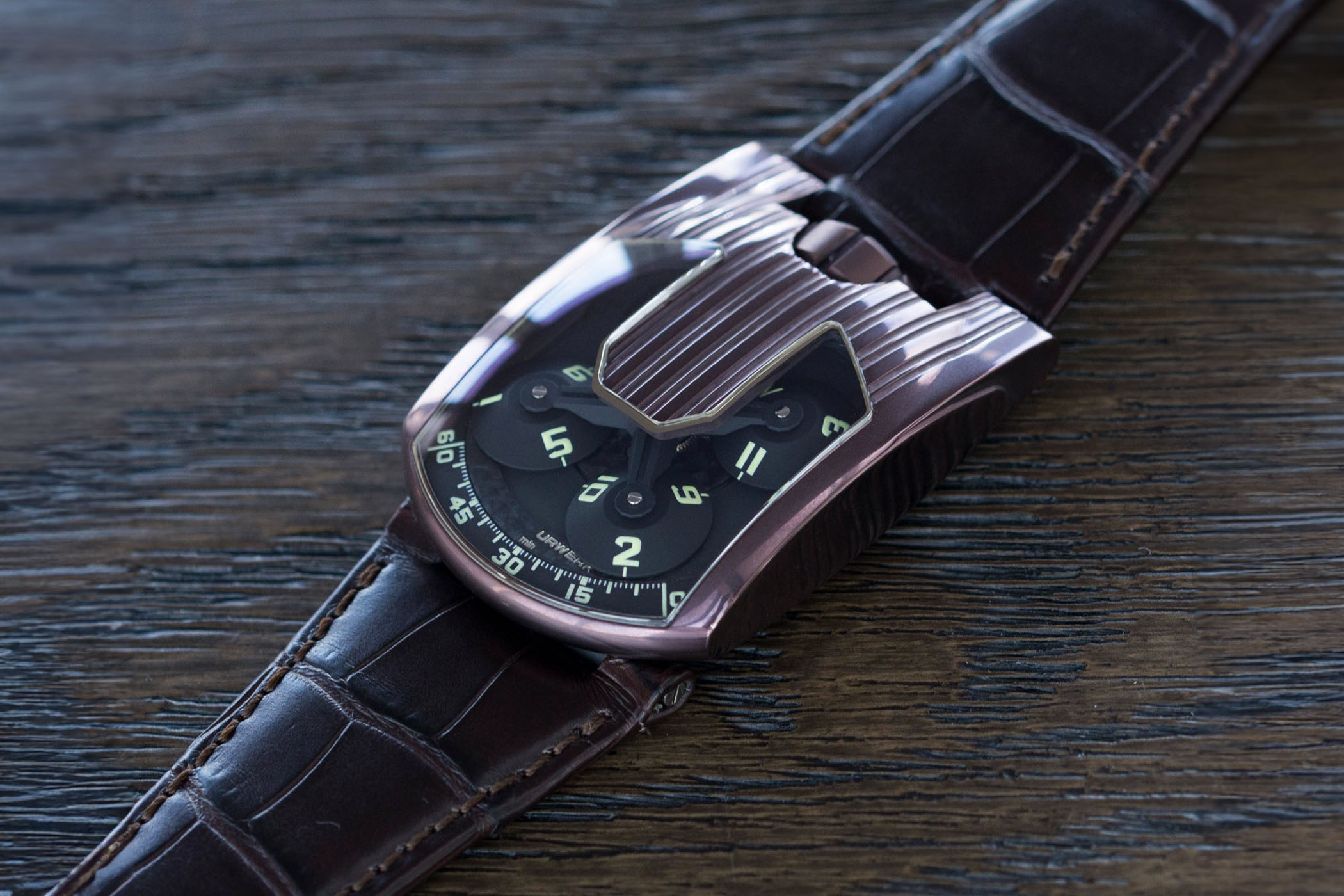
Readers of The Collector’s Series and the Collector’s Corner know that I sometimes contribute to the column – writing articles for the series is just one more way for me to get excited about vintage watches. I read a little about a specific watch, go deeper down the rabbit hole, and before I know it, I’m looking for listings on Chrono24. Sometimes, I write weird, off-kilter posts like that time in October 2022 when I visited Ond?ej Berkus’ atelier (and also a couple of weeks ago) and spent the day talking about watches and life with him. For this artistic freedom, I thank the team at MONOCHROME! This piece falls in that same vein. Call it my way of becoming better acquainted with a piece I own; call it the ramblings of someone who has now well and truly lost all his marbles. In any case, I hope you enjoy the ride. Because the story of this Urwerk UR-103 is quite a complex one.
Editor’s Note: @aaaaaaaaaarian should be credited for some of the photos found in this article (images with a dark background). The opening image should be credited to www.acollectedman.com.
Backstory
The Urwerk UR-103 is a watch that I never expected to own. I spent most of the Covid-19 pandemic hunting for and owning neo-vintage pieces like the Cartier Tank Américaine, the Breguet Ref. 3237, or the Jaeger-LeCoultre Reverso Chronographe Rétrograde. Some would say I exposed myself too quickly to one genre of watches. Tastes change, as do collecting preferences and priorities in life. I wasn’t immune to the latter, and major life changes necessitated the difficult decision to part ways with most of my neo-vintage collection.
However, even before that, I had been thinking of taking my collection in a very different direction. I had already dabbled in indies, purchasing a Habring2 Foudroyante Felix as a way of showing my support to the watchmaking scene in Austria. I admired independent watchmaking and what it stands for; new designs, materials, complications, and the feeling of wonder and amazement the watches inspire in me. My collector friend circle played a big part in this, exposing me to indie after indie – @aguy2watch is an especially egregious example of this. As my collecting journey progressed, I asked myself: why even own a mechanical watch? I mean, if you want to know the time, just whip out your phone and take a look. It’s as easy as that. There is no need to own an expensive, more likely than not fragile, and mechanically obsolete timekeeper.
No, we buy these objects for the emotions they invoke in us, and I realized that as beautiful as the watches in my collection were, they were maybe a bit too conventional, a bit too “normal” for me.
I am a child of the 1990s. Star Wars is one of my favourite franchises (well, before Episodes 7, 8, and 9 came out, that is. We don’t talk about those…), so much so that at one point, I had the whole scripts of Episodes 1-6 memorized. I don’t remember exactly when I first saw the URWERK UR-103. Maybe it was one of the two times it was featured in the Collector’s Series (here and here), maybe it was an old Instagram post. There was something about the watch that resonated with me. It looked like something out of the Star Wars universe. It was a technical yet organic aesthetic, and it looked altogether alien. I couldn’t help but see the parallels of the case design with the flowing curves of the Covenant’s ships in the Halo franchise. The case and the curved sapphire were uniquely sculptural. The massive crown at 12 o’clock looked like some kind of exhaust jet. I was hooked.
I looked through the more recent URWERK references, and even though my appreciation of the brand’s designs and technical accomplishments only grew, the 103 resonated with me the most. It had not entirely adopted the techno-industrial aesthetic of modern URWERK, instead maintaining a more sensuous, curvy form. Also, the 103 represents the pivotal movement of success for the brand, one which anchored their design language and set the stage for the developments to come. And, not to skirt around the topic, there’s the price factor – modern URWERK is way out of my budget!
As my consolidation progressed, I decided to pursue the UR-103 more seriously. Some folks I talked with actually recommended not buying one, that it would be too large, that it’s the wrong watch for me, that it doesn’t fit me or my style. Being the stubborn person I am, I disregarded all this advice. The opportunity to see the watch in person presented itself when, again, thanks to @aguy2watch, I had the chance to visit the URWERK headquarters in Geneva in March 2023. There, finally, I had the chance to not just hold the UR-103 in red gold and experience it but also to try it on. It looked amazing, and it felt right on my wrist. And, most importantly, it didn’t look too big. Cue the want.
The search continued, sometimes more intensely than not, and when the right trade opportunity presented itself for a special UR-103.08, I jumped on it.
A closer look at the UR-103.08
URWERK is now 26 years old, having celebrated its 25th anniversary in 2022. Unarguably, the UR-103 is the reference that firmly cemented the design language of the brand and allowed it the financially stable footing that permitted further experimentation. The 103 marked a break from the “old” world of watchmaking – the new millennium required a new way of telling the time, one that respected the past while still exploring new paths.
The UR-103 was presented at the AHCI stand at Baselworld 2003 – remember, this was a different era. We hadn’t seen crazy MB&F Horological Machines yet, and watches still tended to be round things. For some perspective, Rolex unveiled its 50th-anniversary Sub “Kermit” the same year. It feels like a century ago…
The 103 was a revelation, one that required a fundamental rethink of watchmaking materials as it did a rethink of what a mechanical wristwatch could be. The orbiting satellites, being 160 times heavier than traditional hands, necessitated the use of non-traditional alloys. Cue aluminum satellite discs, non-magnetic ARCAP P40 for the base plate, grade 2 titanium orbital cross, and a grade 5 titanium caseback for the Control Board indications.
The UR-103.08 features a “standard” 103 Targa case with a curved sapphire crystal. The 103.08 marks a happy middle ground between the early 103.03, which had 12 sets of engraved grooves, and the 103.05, which only had 6. The 10 sets of grooves create visual interest while leaving a smooth, polished border that frames the time display. To me, this is a small touch that adds so much to the design – that little extra bit of smooth, curved and polished metal echoes the swooping shape of a 1930s sports car. The 103.08 case is made out of stainless steel, which also marks a first for a series-production variant in the model family. On top of the steel, URWERK then applies a coating of TiAlN (Titanium Aluminum Nitride), which not only makes the watch extremely resistant to scratches but also lends a warm purple-brown hue.
URWERK describes it best in one of its preowned watch listings: “Titanium Aluminum Nitride. A treatment well-known in the industrial industry for its exceptional properties. A TiAlN coating that is less than 4 microns thick and has the effect of multiplying the resistance of the underlying metal to scratches, shocks, oxidation and even acids. Applied to tools when machining metals to guarantee the tool head is harder than the material to be machined. Harder than DLC and has a Vickers rating of 3500. To put it into context, steel is only 600 Vickers, and sapphire is 4000. The purple/brown tones are created from how the Titanium and Aluminum are mixed; the result is a first in the watch industry.”
So what is the watch like on the wrist? The UR-103.08 has an unconventional shape, so best to break down the measurements. The width from 3 o’clock to 9 o’clock is the most straightforward, at 36mm. At its longest, the case measures 49mm, though, since the crown sits inboard of the outermost outcropping of the lugs, the watch does not look it. Where it gets really difficult is the thickness, so I’ll give you three measurements: at where 6 o’clock would traditionally be (6mm), in the middle of the case (14mm), and at where 12 o’clock would traditionally be (13mm).
On the wrist, the watch wears remarkably light. This is due to the steel case, titanium caseback, and large sapphire surface. Additionally, the use of aluminum for the satellite discs and an ARCAP P40 (a non-ferrous copper-nickel-zinc alloy) baseplate certainly helps. The 103.08 takes up quite a lot of wrist real estate but never feels uncomfortable. I think this is quite an achievement, seeing as I sold a Speedmaster Professional because I didn’t enjoy how it sat on my wrist and hated its tendency to get hung up on door sills, my desk, and every sleeve in my wardrobe!
It’s the interactions that count – watchfam
Episode 1: I was in London in August 2023 and reached out to some #watchfam in the city to ask if they would have the time for a chat and dinner. Sadly, only one person made it. Happily, that person was @f1ptb, a champion of the independent scene at the highest level of collecting.
Alongside @aguy2watch, @nuewatchguy, and @apexluxuryuk, @f1ptb is the guy I bombarded with questions about usability, legibility, day-to-day wearing comfort, and overall experience with the 103. Connecting with these collectors, and taking wrist shots while wearing the same base reference – these are some of the highlights of my watch collecting journey thus far!
Episode 2: Thanks to Ond?ej Berkus’s invitation to pick me up from Brno to drive to Prague together, I decided to tag along for Salon of Exceptional Watches in late October 2023. What happened those two days was terrific proof that I had made the right decision with the 103. So many people came up to me and asked what was on my wrist… after I handed it to them, they strapped the 103 on their wrist with a look of wonderment, then handed it back to me, grinning ear to ear. It was a joy to experience that same rush again when I first saw the watch – this is indie watchmaking at its very core, and I don’t think it will ever get old!
Here’s to many more!
Q&A with Martin Frei
As a way to get to know the watch better and learn about its inspiration and history, I reached out to URWERK through their Owner’s Lodge. The edited Q&A is below for your reading pleasure!
Special thanks go to Yacine Sar, Head of Communications at URWERK and to Martin Frei, who took the time to go through my exhaustive list of questions.
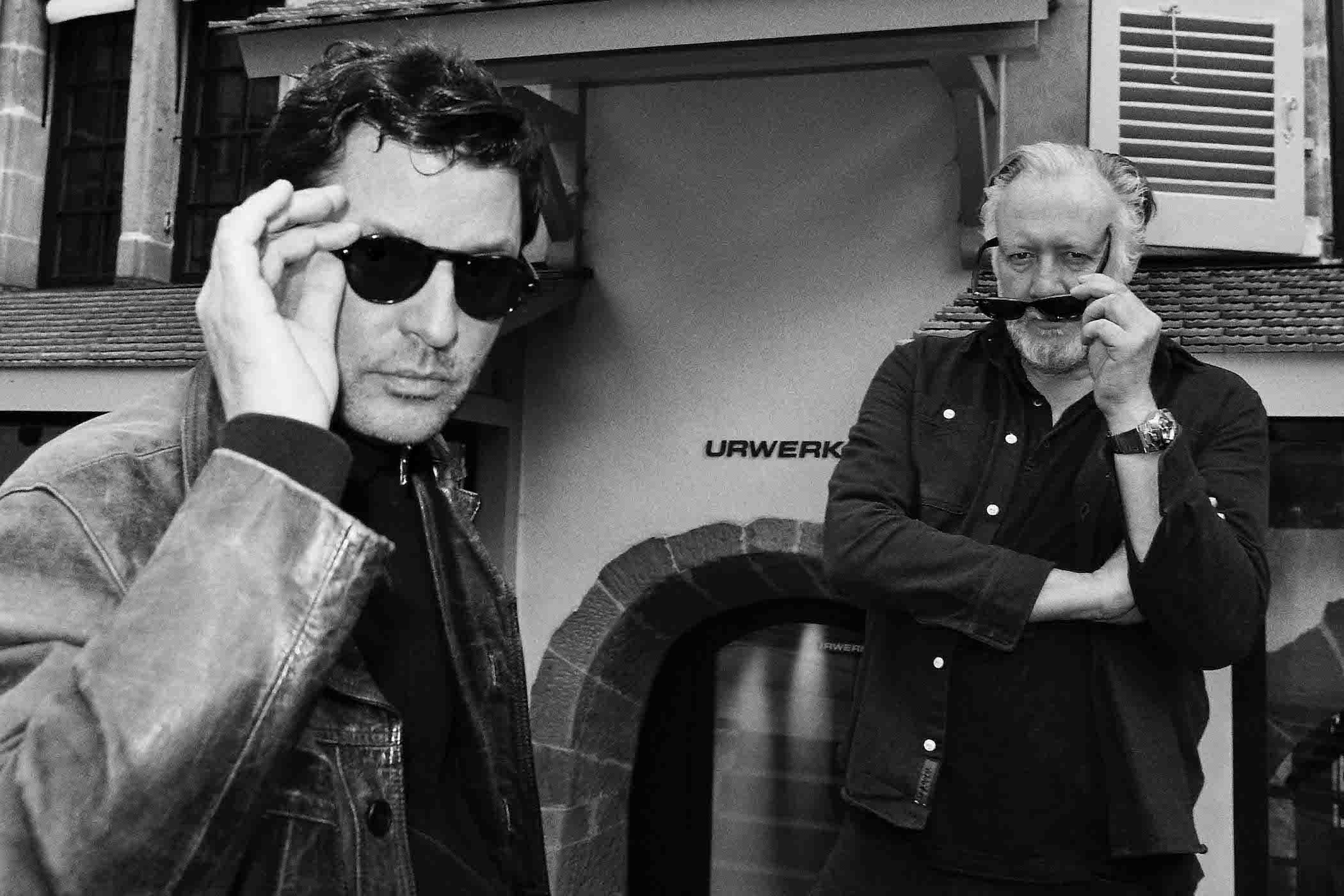
Suhrud: What were the inspirations for the original design of the UR-103?
Martin Frei: We initially created our two first watches UR-101 and UR-102. That was before the Millennium, in the old century …
Crossing into the Year 2000 marked a significant milestone for us: it was the big leap. To commemorate this transition, we dedicated the UR-101 to the Millennium, and the Millennium Falcon was one of the inspirations for its design. This was when the distinctive, asymmetrical URWERK layout came to life.
The UR-103 brought a fresh perspective, influenced by the insights of Felix Baumgartner’s father – a distinguished clock specialist – we turned the watch into a driver’s one. This led to a significant shift in design, with the time indication relocated to the opposite side of the case, facing the wearer. The big crown found its new place on the upper side where it was therefore well protected and not bothering the wrist. The UR-DNA was born.
The case, now more complex, had to be made by CNC machining – a departure from our initial handmade cases – and that also allowed us to machine-engrave the case with streamlined grooves.
Were there other designs for the UR-103 that were close seconds?
No, the UR103 was a clear-cut piece, a creation that merged the circular principle with the square one.
How long did it take to machine a UR-103 case in steel? In white gold/red gold? In platinum?
It really depended on whether the watch was engraved and the type of material it was created from. At that time, a fairly simple round watch case in steel or gold involved: eight hours to program the machine; four hours to regulate/adjust the tools; 30 minutes to actually make the case; using up to five standard tools (drills, etc.); two case position changes (front and back); and 200 cases made before needing to replace tools.
To make a gold case 103.03 took approximately: three full weeks to program the machine, one full week to regulate/adjust the tools; seven hours to actually make the case; 15 standard tools and four special tools; six case position changes; and 50 cases made before needing to replace tools.
To make a platinum case 103.05, the figures were even “worse”: four and a half weeks to program the machine, three full weeks to regulate/adjust the tools; over two days to actually make the case; 15 standard tools and eight special tools; six case position changes; and five cases made before needing to replace tools.
Do you have any schematics / technical drawings from the movement development or overall development phase that you would be willing to share and have published on MONOCHROME Watches?
We have these plans with URWERK Geneva, and I certainly can share an early sketch of the watch…
What were the production volumes of the various UR-103 references?
I do not have precise figures. I know that already back then, the UR-103 was a pretty well-selling watch. However, the production was very limited and exclusive. Modern CNC machining allowed us to make case with more precision and complexity, but it is not magic.
What were the biggest challenges in making the UR-103?
For us, there were quite a few challenges connected to this moment in time. The whole production had to be financed by selling a few pieces. Technically we began to explore new possibilities with the help of CNC machines. The spherical crystal glass had to be cut out of sapphire in its unconventional shape and fit into the iconic case of the UR-103; that was not that easy at all! We were among the first, if not the first, to have fully curved glasses to give this 3D effect to our watches.
How do the founders see the current market for independent watchmaking?
For a few years now, we have been feeling a wave of love for independent watchmakers and independent watchmaking. Definitely hope this will last …
What are URWERK’s plans going forward? New complications? New materials? What can we expect to see? (nothing confidential, of course)…
Our motivation is to express our very own take on contemporary watchmaking, creating our timepieces. URWERK is a project of the Avantgarde and, therefore, it is a program for us to always invent and be inspired by the moment…to boldly go where no one has gone before!
The Urwerk UR-103 through the years
Below is an overview of the various UR-103 references, along with production volumes, whenever I found them (references include URWERK’s own pre-owned shop and auctions). The 103 was in production for 7 years, and over the span, the model evolved so far from being a reference family that I think it is safe to call the 103 a model family.
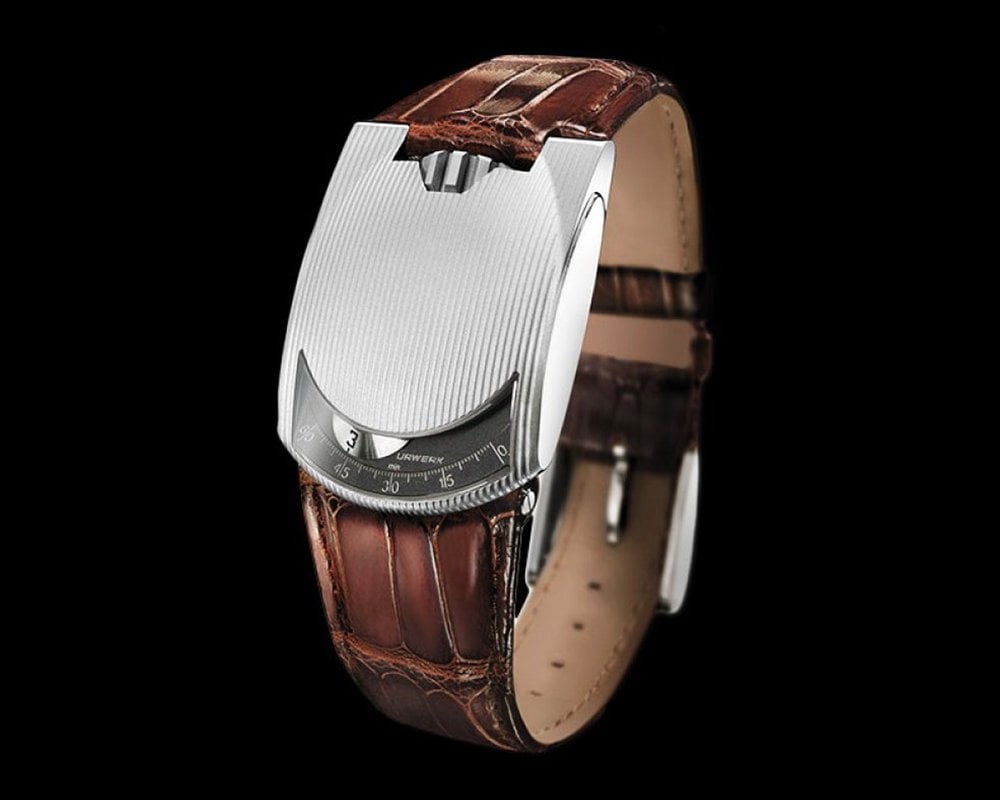
- UR-103.01 EW: Watch available in 18k white gold or 18k red gold, each limited to 25 pieces, with a case characterized by narrow spacing between case engravings that continue past the minutes track, small sapphire cutout for hours and minutes only
- UR-103.03: the first UR-103 with a “targa” sapphire crystal shape, 12 sets of double engraved grooves in the case, production volume unknown for both white gold and red gold
- UR-103.05: fully polished platinum case with sapphire crystal windows in cut-outs in the case flanks, broader spacing between case etching grooves compared to earlier editions (only 6 sets of grooves in total), limited edition of 50 pieces.

- UR-103 Blackbird: platinum case with no case engravings coated with black PE-CVD, dial, satellites, orbital cross black PVD-coated, 2006 edition limited to 10 pieces.
- UR-103.06 JOAILLERIE: case, crown, buckle paved with 277 white diamonds for a total gem weight of 5.28 carats, limited to 25 in gold and 10 in platinum.
- UR-103.07: case in rose gold or white gold, with case engraving pattern similar to UR-103.05 in number and positioning.
- UR-103.08: steel case with glossy TiALN (Titanium Aluminum Nitride) treatment, 10 sets of double grooves. Limited edition, production count unknown, but likely above 100 pieces based on examples of serial numbers I have seen. The UR-103.08 is also available in a presumably rarer version that features an angular sapphire crystal cutout. Production count unknown.

- UR-103.09: case in rose gold, white gold, 10 sets of double grooves, no engravings below the minutes track.
- UR-103.09 AlTiN Black Steel: steel case with matte black AlTiN treatment, limited edition of 5 pieces.
- UR-103.10 BPT Hexagon: platinum case PE-CVD treated with glossy black coating, angular sapphire cutout, 2008 limited edition of 10 pieces.

- UR-103T Tarantula: case in 18k 5N red gold, 18k white gold, or steel treated with AlTiN; red gold and steel limited to 60 pieces each, white gold to 33 (thanks to @detroitwatchguy for the details on the AlTiN steel variant – read his interview about his personal UR-103 here)
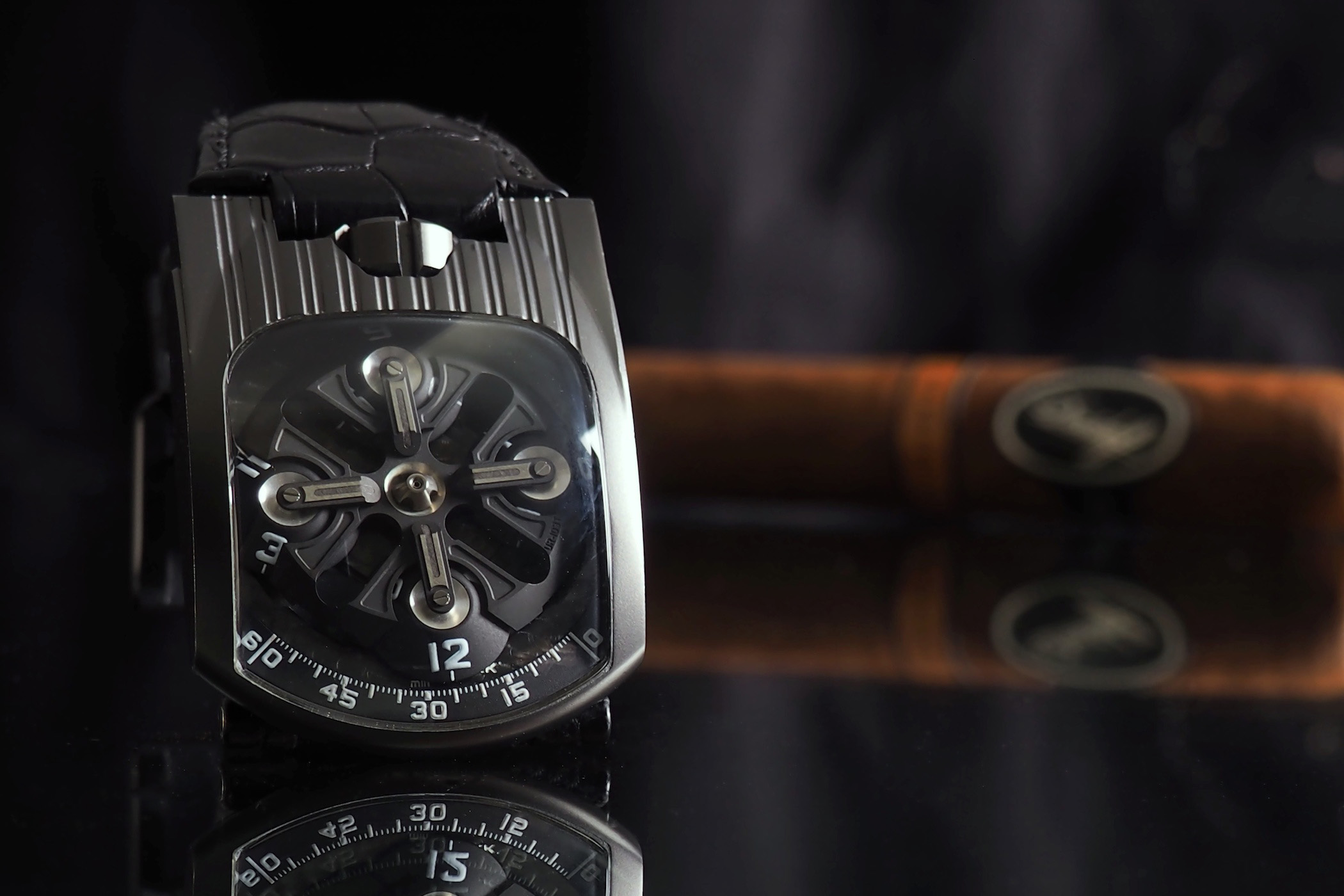
To close out the UR-103 model line, URWERK announced three special editions in 2010:
- UR-103T “Mexican Fireleg”: UR-103 Tarantula with modified colour scheme featuring orange luminescent markings, hours indications, and minutes track. Limited edition of 60 pieces in stainless steel treated with AlTiN (Aluminium, Titanium, Nitride) or 18k gold treated with AlTiN
- UR-103TS “Shining T”: 18k gold case treated with AlTiN, hour satellites in sapphire, limited edition of 33 pieces
- UR-103 Phoenix: piece unique for Only Watch 2011, case in white gold, decorated with a phoenix motive hand-engraved by Jean-Vincent Huguenin
- The “UR-103 Edition Spéciale” comprise a number of elaborately hand-engraved piece unique, including the “Dragon” in 18k red gold, “Junkers” in platinum, “Art Deco” in 18k white gold, “Eagle” in platinum.
Did I miss any? Have anything to add? Do reach out in the comments below!




